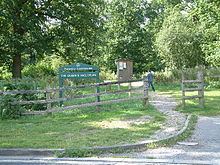The Forest of Bere is a mixed-use partially forested area immediately north of Fareham, Portsmouth and Roman Road, Havant and includes a small part of the South Downs National Park It is featured in the TV series Vikings episode Eye for an Eye. The former uninterrupted forest is today a mix of woodland, open space, ponds, streams, heathland, farmland and downland interspersed by minor villages and the major settlements of Waterlooville (with Cowplain) and Eastleigh (with Chandlers Ford). It provides countryside access to the residents of South-East Hampshire having a number of paths and bridleways for walking and cycling. In particular in the southern portion, towards the area south of the Queen Elizabeth Country Park in the 20th century conifer plantations have been planted.
In the 13th century there were two royal forests royal forest in Hampshire between the New forest and the Sussex border; Bere Ashley and Bere Portchester. To the north of Southampton; between the rivers Test and Itchen, lay the Royal Forest of Bere Ashley. To the north of Portsmouth; between the river Meon and Bedhampton, lay the Royal Forest of Bere Portchester.
Woodland habitats and contiguous Country Parks
Listed from east to west, excluding small copses and coppices
Southleigh ForestStaunton Country ParkThe Holt with Stein Wood and Havant ThicketBells CopseOuthills Copse with Stakehills Coppice and Beech WoodBushy Lease with Neville's Park and Littlepark WoodThe Queen's Inclosure in WaterloovilleNewlandsmoor Coppice with Malin's Coppice, Drivett's Coppice, Portland Coppice, Potwall Coppice, Broomground Coppice and Greathunt CoppiceDunsland Coppice with Wards Coppice and Fareham Garden (wood that adjoins above group)Sawyer's WoodCreech WoodsPlace WoodMitchelland CopseStroud CoppiceHipley CopseWaltonheath Plantation with Ashlands Plantation and Staplecross CopseGoathouse Copse with Russell Copse and Kiln WoodGrub Coppice with Mill CoppiceWest Walk (one of the largest woods) (with Lowerfield Copse and Upperfield Copse)Dirty Copse with Great Holywell CopseMill Copse with Hoegate Commons, The Purlieu and Huntbourn WoodOrchard Copse with Birching CopseClose Wood and Bishop's WoodShaftesbury Copse, Aylesbury Copse with Ravens Wood, Birchfield Copse, Dash Wood, Dandy Copse and Fiddlers GreenMushes Coppice with Everitts Coppice, Stonyfield Copse, Flagpond Copse, Sager's Moor, Dimmock's Moor, Ridge Copse, Blackmoor Copse, Waterclose Copse and Sawpit CopseBrook Wood with Horse Wood, Hallwood Copse, Mansfield High Wood, Hole Copse and Silford CopseJacob's Croft, Hangman's Copse, Blacklands Copse, Birch Row, Alder Moor, Maids' Garden Copse and Botley Row (wood that adjoins above group)Gull Coppice and Bushy Land, in SwanwickWellspring Copse with Swanwick WoodManor Farm Country Park with Dock Copse, Catiland Copse, Vantage Copse and Durncombe's CopseNetley Common with Dumbleton's CopseTelegraph Woods with Beacon Hill Woodland ParkHog Wood with Milkmeads Copse, Vocus Copse, High Wood and/in Itchen Valley Country ParkHome Wood with Smithys Wood, Cox's Rough, Hut Wood, Marshall's Rows, Spring Copse and Chilworth CommonOtterbourne Park Wood and Pitmore CopseHome Copse, Long Copse and Rownhams PlantationThe woods that cover most of Cranbury ParkWindmill CopseHocombe Plantation with Trodds CopseBroadgate PlantationAmpfield Wood with Neville's Copse, Amprield Plantation and Hursley Forest
